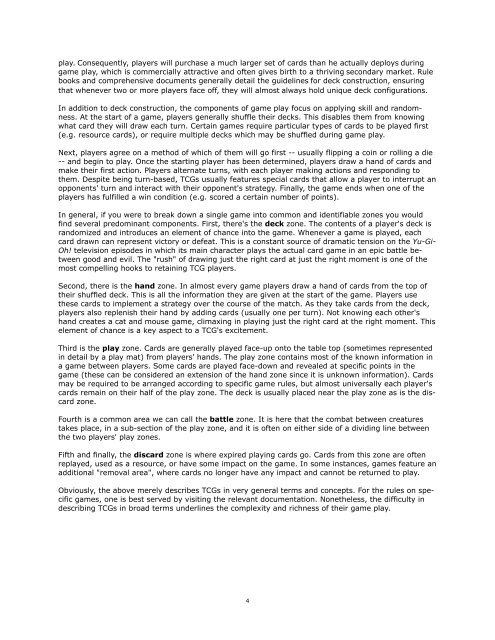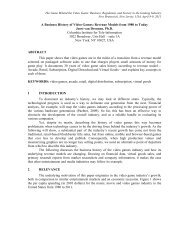Trading Card Game Industry White Paper - SuperData Research
Trading Card Game Industry White Paper - SuperData Research
Trading Card Game Industry White Paper - SuperData Research
Create successful ePaper yourself
Turn your PDF publications into a flip-book with our unique Google optimized e-Paper software.
play. Consequently, players will purchase a much larger set of cards than he actually deploys during<br />
game play, which is commercially attractive and often gives birth to a thriving secondary market. Rule<br />
books and comprehensive documents generally detail the guidelines for deck construction, ensuring<br />
that whenever two or more players face off, they will almost always hold unique deck configurations.<br />
In addition to deck construction, the components of game play focus on applying skill and randomness.<br />
At the start of a game, players generally shuffle their decks. This disables them from knowing<br />
what card they will draw each turn. Certain games require particular types of cards to be played first<br />
(e.g. resource cards), or require multiple decks which may be shuffled during game play.<br />
Next, players agree on a method of which of them will go first -- usually flipping a coin or rolling a die<br />
-- and begin to play. Once the starting player has been determined, players draw a hand of cards and<br />
make their first action. Players alternate turns, with each player making actions and responding to<br />
them. Despite being turn-based, TCGs usually features special cards that allow a player to interrupt an<br />
opponents' turn and interact with their opponent's strategy. Finally, the game ends when one of the<br />
players has fulfilled a win condition (e.g. scored a certain number of points).<br />
In general, if you were to break down a single game into common and identifiable zones you would<br />
find several predominant components. First, there's the deck zone. The contents of a player's deck is<br />
randomized and introduces an element of chance into the game. Whenever a game is played, each<br />
card drawn can represent victory or defeat. This is a constant source of dramatic tension on the Yu-Gi-<br />
Oh! television episodes in which its main character plays the actual card game in an epic battle between<br />
good and evil. The "rush" of drawing just the right card at just the right moment is one of the<br />
most compelling hooks to retaining TCG players.<br />
Second, there is the hand zone. In almost every game players draw a hand of cards from the top of<br />
their shuffled deck. This is all the information they are given at the start of the game. Players use<br />
these cards to implement a strategy over the course of the match. As they take cards from the deck,<br />
players also replenish their hand by adding cards (usually one per turn). Not knowing each other's<br />
hand creates a cat and mouse game, climaxing in playing just the right card at the right moment. This<br />
element of chance is a key aspect to a TCG's excitement.<br />
Third is the play zone. <strong>Card</strong>s are generally played face-up onto the table top (sometimes represented<br />
in detail by a play mat) from players' hands. The play zone contains most of the known information in<br />
a game between players. Some cards are played face-down and revealed at specific points in the<br />
game (these can be considered an extension of the hand zone since it is unknown information). <strong>Card</strong>s<br />
may be required to be arranged according to specific game rules, but almost universally each player's<br />
cards remain on their half of the play zone. The deck is usually placed near the play zone as is the discard<br />
zone.<br />
Fourth is a common area we can call the battle zone. It is here that the combat between creatures<br />
takes place, in a sub-section of the play zone, and it is often on either side of a dividing line between<br />
the two players' play zones.<br />
Fifth and finally, the discard zone is where expired playing cards go. <strong>Card</strong>s from this zone are often<br />
replayed, used as a resource, or have some impact on the game. In some instances, games feature an<br />
additional "removal area", where cards no longer have any impact and cannot be returned to play.<br />
Obviously, the above merely describes TCGs in very general terms and concepts. For the rules on specific<br />
games, one is best served by visiting the relevant documentation. Nonetheless, the difficulty in<br />
describing TCGs in broad terms underlines the complexity and richness of their game play.<br />
4






